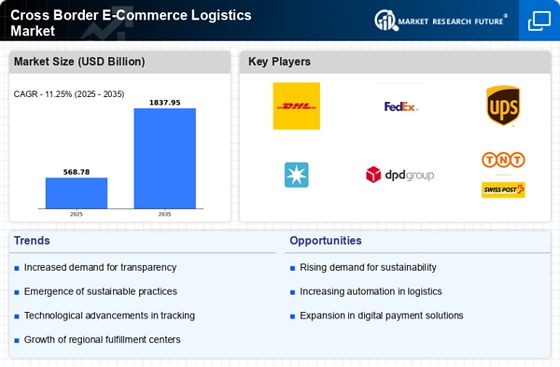The Cross Border E-Commerce Logistics Market is currently characterized by a dynamic competitive landscape, driven by the increasing demand for efficient and reliable logistics solutions across global borders. Key players such as DHL (DE), FedEx (US), and UPS (US) are strategically positioning themselves through a combination of technological innovation, regional expansion, and partnerships. These companies are not only enhancing their operational capabilities but also adapting to the evolving needs of e-commerce businesses, which increasingly prioritize speed and reliability in their logistics operations. The collective strategies of these major players contribute to a moderately fragmented market structure, where competition is fierce yet offers opportunities for differentiation through service quality and technological advancements.
In terms of business tactics, companies are increasingly localizing their operations to better serve regional markets, optimizing supply chains to reduce costs and improve delivery times. The competitive structure of the market appears to be moderately fragmented, with several key players exerting significant influence. This fragmentation allows for niche players to emerge, focusing on specific regional needs or specialized services, thereby intensifying competition among established giants.
In August 2025, FedEx (US) announced a strategic partnership with a leading e-commerce platform to enhance its last-mile delivery capabilities. This collaboration is expected to streamline operations and improve delivery efficiency, which is crucial in meeting the rising expectations of consumers for faster shipping options. The partnership underscores FedEx's commitment to leveraging technology and collaboration to maintain its competitive edge in the logistics sector.
In September 2025, UPS (US) launched a new digital platform aimed at optimizing cross-border shipping processes for small and medium-sized enterprises (SMEs). This initiative is particularly significant as it addresses the growing demand from SMEs for accessible and efficient logistics solutions. By simplifying the shipping process and providing real-time tracking, UPS is likely to enhance customer satisfaction and loyalty, positioning itself favorably in a competitive market.
In July 2025, DHL (DE) expanded its operations in Asia by opening a new logistics hub in Singapore, aimed at facilitating faster cross-border e-commerce transactions. This strategic move not only enhances DHL's operational capacity in a key growth region but also reflects its focus on regional expansion to capture the burgeoning e-commerce market in Asia. The hub is expected to improve delivery times and service reliability, further solidifying DHL's market position.
As of October 2025, the competitive trends in the Cross Border E-Commerce Logistics Market are increasingly defined by digitalization, sustainability, and the integration of artificial intelligence. Companies are forming strategic alliances to enhance their service offerings and operational efficiencies, which is reshaping the competitive landscape. The shift from price-based competition to a focus on innovation, technology, and supply chain reliability is becoming more pronounced, suggesting that future competitive differentiation will hinge on the ability to adapt to these emerging trends.

















Leave a Comment